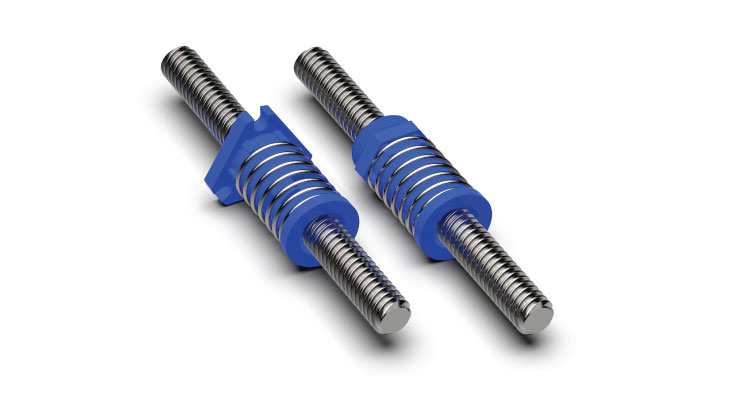Top Questions About Lead Screws in Mechanical Design

Lead screws have increasingly become the linear motion control solution of choice for mechanical design. The use of lead screws for providing actuation in machine designs and other types of the mechanical design is growing because of advances in lead screw design, screw and nut materials, and manufacturing technologies.
Lead screws are power transmission products that use deep helical threads and a mating nut, usually made of a polymer composite or bronze, to control linear motion in mechanical designs. This article examines commonly asked questions and answers about the use of lead screws for mechanical design.
Q: What is a lead screw?
A: A lead screw is a threaded screw that utilizes the helical configuration of the threads to control linear actuation when combined with a mating nut. The most well-known lead screw is the Acme screw, which has a 29° thread angle with a thread height half of the pitch, the distance between a point on one thread, and a corresponding point on the following parallel thread axis. Precision lead screw assemblies can be configured with trapezoidal thread forms with thread angles ranging from 30º to 40°, providing greater strength for larger loads. The efficiency of a lead screw is highly dependent upon the helix angle of the screw thread.
Q: What are the advantages of using lead screws for linear actuation in mechanical designs?
A: Lead screws are cost-effective and self-locking (do not require a braking system) and provide the accuracy and repeatability needed by most mechanical design applications.
Q: What causes the generation of noise in a lead screw assembly during actuation?
A: Lead screws generally operate quietly, but when a lead screw makes noise, it is typically caused by a combination of the material used for the screw and/or nut, the alignment of the lead screw assembly, or the linear motion control system’s orientation. The exact cause of lead screw noise should be determined on a case-by-case basis because of the potential combination of variables. Solutions to dampening noise in lead screw assemblies include changing system speed, improving alignment, and controlling vibration.
Q: What characteristics contribute to reduced lead screw vibration within a lead screw assembly?
A: Features that can influence lead screw vibration include screw straightness, screw length, and journal runout (radial play in the assembly).
Q: What type of lead screw is best for applications that do not require precise accuracy?
A: The exact configuration depends on the load and speed of the application, but generally speaking, a lead screw with a standard nut rather than an anti-backlash nut would be best.
Q: When should you adjust the tension of the backlash-reducing nut?
A: Adjusting the tension of the backlash-reducing nut is best left to the experts to set at the factory because it is highly dependent on nut design.
Q: What is a preloaded anti-backlash nut?
A: The nut in a lead screw assembly can be preloaded to eliminate axial free play in the assembly. Typically preloading a nut is generally done by creating an assembly that utilizes two nuts and a spring between them. (Pictured to the right)
Q: What is the difference between lead and pitch?
A: The lead in a lead screw assembly is the axial distance that the nut travels after one complete revolution of the screw. The pitch in a lead screw assembly is the axial distance between a point on one thread and a corresponding point on the following thread. The lead is equal to the pitch times the number of starts, and the pitch is similar to the lead in a single start screw.
Q: Is there a way to protect lead screws from falling debris?
A: You can protect the lead screw assembly with an extruded aluminum enclosure, an accordion-style boot, a seal, or a wiper, depending on the application and the type of operational environment.
Q: Will a long lead screw assembly bend, and if so, is there a solution to eliminate bending?
A: Under specific loading scenarios, a long lead screw can bend. One possible solution when using long lead screws is to use intermediate supports, such as a spring-loaded arm with a plastic sleeve that supports the screw during operation but drops away from the assembly as the nut passes.
Q: What does efficiency mean when referring to lead screw or ball screw?
A: The efficiency of a screw refers to how well it converts rotary energy into linear energy or motion. Ball screws are more efficient because they utilize rolling contact instead of the sliding contact of a lead screw. Rolling contact has a lower coefficient of friction than sliding contact, and ball screws provide a relatively constant efficiency rate of greater than 90 percent. Lead screws, including Acme screws, offer efficiency levels of between 20 percent and 80 percent and operate purely with sliding contact. You can improve lead screw efficiency by increasing the helix thread angle and using PTFE dry lubricant coatings and grease.
Contact HELIX Linear Technologies to learn how you can use precision-engineered lead screws as a cost-effective, high-performance option for linear actuation in machine designs and other types of mechanical design. HELIX Linear offers a wide array of highly configurable lead screws that can provide the accuracy, repeatability, and performance that you need to effectively and affordably control linear motion in all types of machinery and mechanisms.


